Hot dogs are a classic and nostalgic food that generations of Americans have enjoyed. Memories of celebrating the Fourth of July, for example, are often associated with grilling the food by the pool or out on the deck. People crave hot dogs at the fair, the carnival, or the boardwalk. Hot dogs are hardly new to the consumer conscious, but industry professionals in the category are working to keep them relevant to modern diners.
During the pandemic, online ordering and third-party delivery boomed, and the trend has proved to have lasting power—something that translates well to hot dogs. Being stuck at home brought a return to the comforting, nostalgic food people grew up with, now available through a few clicks on their mobile devices. One of those items was undoubtedly hot dogs. What normally is an occasion-based food shifted into an opportunity for convenience.
Jenn Johnston, president of the QSR division at FAT Brands, where Hot Dog on a Stick is housed, says the pandemic surge continues to adjust dayparts. The snack brand’s year-to-date sales and transactions are each up 10 percent. “I think that is a testament to consumers really continuing to crave comfort foods post pandemic,” Johnston says.
Hot Dog on a Stick has 50 units, with the majority located in shopping malls, and a smaller footprint on boardwalks and amusement parks. Before the pandemic, the brand mostly drove customers to stores by being located in foot traffic-heavy locations where they were out shopping or having fun, and wanted a quick bite to eat. After, like many other quick-service brands, Hot Dog on a Stick had to adjust. The chain had not majorly delved into the world of third-party delivery yet. “Our products are made fresh to order when people get to the counter, so we hadn’t really anticipated the demand for people ordering to go and enjoying them later in their home,” Johnston says. “With the pandemic we ended up putting all of our stores on third party delivery and online ordering.”
Johnston also notes that because hot dogs can be a snacking occasion or a meal for consumers, many will order multiple hot dogs in each order. This leaves room for innovation in the category, especially at Hot Dog on a Stick—if a customer orders dinner and wants to try a new kind of hot dog, they might get one newer option alongside their classic favorites. One popular offering of late has been the LTO Flaming Hot Cheetos hot dog, Johnston says. She also adds a large portion of transactions are ordered with a lemonade, another item the brand likes to focus on in terms of R&D. The brand offered a “Pineberry” flavor throughout the holiday season, for instance.
Wienerschnitzel, which claims to be the nation’s largest hot dog chain, also focuses on innovation to inspire trial and encourage repeat visits from loyal users, chief marketing officer Doug Koegeboehn says. The brand has rolled out pretzel buns and different toppings for fresh kinds of hot dogs. Koegeboehn says he believes toppings are where innovation thrives in the hot dog business. One of Wienerschnitzel’s popular creations is called a “junkyard dog,” which has chili cheese fries on top. However, the brand finds sticking to its classic menu items generally serves it well. “People typically go back to what they actually love,” he says. “Our No. 1 sellers are chili cheese and chili dogs.”
Similarly, Johnston says Hot Dog on a Stick also likes to prioritize its core. “We really try to stay true to our iconic menu first and foremost,” she says. “It gives us a lot of credibility—we do a few things and we do them really well. We spend a lot of time in research and development with numerous items, and only a small amount of them actually make it to market because we want to make sure that if do innovative, it’s a wow factor.”
In terms of playing into the nostalgia of the food group, Koegeboehn says it has its place, but is not the only thing that is important to talk about. You also have to continue promoting their relevance today, he says. “I truly believe the best way to promote any product is showing how it’s relevant in today’s society,” Koegeboehn says. “Nowadays you should be talking about the qualities of the product.”
Leaning into relevance is important, Koegeboehn adds, because of the preconceived notions people may have surrounding the food. Many Americans are still afraid of what is in hot dogs, even if they may love the taste, he says. That’s why Koegeboehn thinks keeping the modernity element in marketing and social media is important. Spreading the word about Wienerschnitzel on social media along with fans of the brand online have made it a viable option for many franchise opportunities to come to fruition. Koegeboehn says area deals have been sold to new franchisees moving across the Midwest, and the brand’s first international deal was signed because of Wienerschitzel’s longevity as a brand.
That nostalgia factor when it comes to hot dogs remains vital, however. It is a driving force behind people’s hot dog cravings and the food’s classification as a comfort category in general. This balance between nostalgia and innovation can perhaps best be seen in Hot Dog on A Stick’s original location that had been open for 75 years on Muscle Beach in Los Angeles. Recently, it underwent a makeover. “It’s still very nostalgic and true to the roots of the original location,” Johnston says. “But it’s been optimized in a lot of ways with modern amenities like air conditioning being added.”








